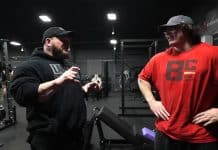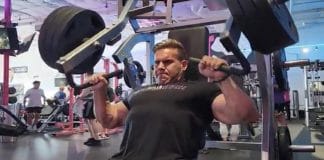Jerry Brainum shares the straight facts on the three key factors involved in muscle hypertrophy – aka muscle growth.
If you are even a casual bodybuilder you have likely heard the term muscle hypertrophy. In simplest terms, muscle hypertrophy is the growth of muscle fibers. It’s a key factor in bodybuilding and sculpting a physique. While any gym goer has likely activated muscle hypertrophy through the act of weightlifting – there is a lot of science behind how this muscle growth actually occurs. Understanding the key factors behind this science can help you optimize your training for better muscle growth. In our latest episode of Straight Facts, Jerry Brainum breaks down everything you need to know about muscle hypertrophy.
So how does one achieve muscle hypertrophy? Resistance exercises, aka weightlifting exercises, are the number one best way to grow muscles. This may seem obvious – but it’s important for beginners to understand that resistance is what activates muscle hypertrophy. It can’t be avoided if you want to build bigger muscle and strength.
So how does this exactly work? When resistance is put on your muscles to the point of overload, muscle fibers are damaged. At this point, satellite cells, which largely remain dormant otherwise, activate to help repair the muscle fibers. During this action of repair – the fibers are built back thicker. Thus, muscle growth occurs.
Another interesting fact is that muscle fibers contain cells with multiple nuclei, which is scientifically called myonuclei. Typically, a cell has one nucleus – but this is not the case for muscle cells. What does this mean? It means that your muscle fibers can atrophy if not consistently kept in a cycle of being overloaded. This is why your muscles shrink if you stop working out.
But a fascinating aspect of myonuclei in muscle cells is that despite atrophy, the number of nuclei does not decrease. This means after taking a break from training, it’s much easier afterwards to build muscle back up when you begin training again.
Ways To Overload Muscle For Hypertrophy
So how does one effectively overload muscle for optimal hypertrophy? There are multiple factors at play that can help you achieve hypertrophy and muscle growth. The first tactic, and most commonly understood, is lifting heavy weight. The definition of heavy weight of course is different for each person and their current strength level. So while we cannot suggest a specific weight to achieve “heavy lifting” – the best way to ensure you are lifting heavy is to lift weight that exhausts you after 6-8 reps per set.
But for those who do not want to lift heavy, there is a way to achieve muscle hypertrophy through lifting light weight. This is done through lifting to failure. Jerry Brainum went into full detail on training to failure in our last week’s episode. Training with lower eight but at a higher volume has been proven to help build muscle. But this is only if you train to failure. Many believe they are training to failure – but do not actually achieve it. Which may lead to hitting a plateau. Often training to failure involves pushing past your perceived limit. It’s challenging and often takes time and experience to fully understand and achieve.
Lastly, you can also achieve muscle hypertrophy by adjusting the rest time between sets. Shortening your rest time puts more stress on your muscle. This leads to muscle growth. However, it should be noted that shorter rest times between sets do not help you build strength. A minimum of 2 minutes between sets are required to recover energy needed to slowly build your strength level. While short rest periods may help muscles grow – you will find your strength plateauing.
The 3 Main Factors Involved in Muscle Hypertrophy
Now that we know how to achieve muscle hypertrophy, what are the actual scientific factors at play behind the actions? Jerry Brainum breaks it down into three main factors. Understanding these factors can help you improve your training regimen for more optimal growth.
The first and easiest to understand is mechanical tension. This is simply the amount of stress or resistance you physically put onto your muscle. This is the underlying factor as to why resistance training is the number one activity for building muscle.
The second factor is metabolic stress. This is when the muscle fatigue byproducts, such as lactate, help stimulate muscle growth. However, this is a debatable issue. While many fitness experts believe there is enough evidence to prove metabolic stress is a real factor in hypertrophy, there are scientists who believe this has yet to be undisputedly proven. For those who wish to achieve a better metabolic stress during muscle hypertrophy – the key tactic to focus on is time under tension. This is how long you are contracting your muscle during a lift.
Lastly, muscle damage is the last factor contributing to muscle hypertrophy. As explained at the top of this article, damage to your muscle fibers lead to satellite cells repairing the fibers. This causes the fibers to be rebuilt thicker. Thus causing growth. But this factor is also under debate in the scientific community. There are those who believe that muscle fibers can be split via muscle damage. These split fibers then become separate fibers that also grow. While this has been observed scientifically in other animals – it has yet to be proven in humans. Though it remains a theory that many believe in.
Wrap Up
As you can see, Jerry Brainum has put together an exhaustive breakdown of everything you need to know about muscle hypertrophy. There are details that we couldn’t fully cover in this article – so be sure to watch the full Straight Facts podcast episode above for full guidance on this important core concept in bodybuilding. Also make sure to stop by every Wednesday for new episodes of the podcast!















